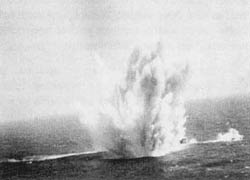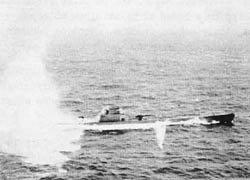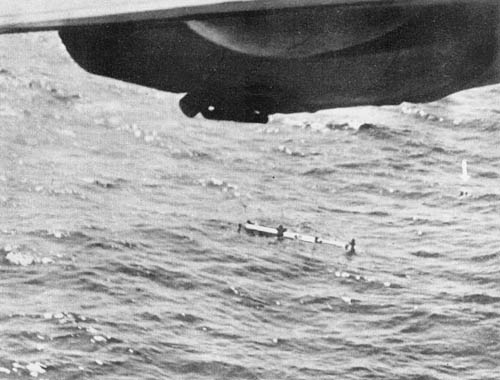Two attacks of B-24 “Tidewater Tillie” from the 2nd Antisubmarine Squadron on German U-boats from Monthly Intelligence Report, No. 3, Army Air Forces, Antisubmarine Command, March 1943:
TIDEWATER TILLIE TAMES TWO
“Tidewater Tillie” is the B-24 in which 1st Lt. W.L. Sanford and his crew of the 2nd Antisubmarine Squadron have recently executed two attacks on enemy submarines which resulted in one probably sunk and one known sunk.
The first attack, illustrated by the accompanying diagram, took place on February 10th about 800 miles west of St. Nazaire while the squadron was operating out of Great Britain. While patrolling at 300 feet at the base of a solid overcast, the left waist gunner sighted a U-boat on the surface 10 degrees off the port bow about four miles away. A radar contact had been obtained in the same position a few seconds before, but due to sea conditions it had not been verified until the visual sighting was made.
When first observed, the conning tower was clearly seen, but as the aircraft approached it disappeared and about forty feet of the stern was seen projecting out of the water at an angle of 20 degrees. As the aircraft attacked no churning was visible from the screws of the apparently motionless U-boat. Six Mark XI Torpex depth bombs spaced for 19 feet were released from 200 feet at 200 mph. The entire stick overshot; the first depth bomb was observed to explode about 30 feet to starboard of the submarine as the tail gunner fired 75 rounds at the exposed part of the hull.
As the pilot circled to port, the U-boat settled back on an even keel with the conning tower visible and both decks awash. A second attack on the still motionless submarine was made with three more depth bombs. The tail gunner fired another 75 rounds and saw the first depth bomb explode on the port side, while a second exploded to starboard. The U-boat appeared to lift slightly, lurching with the force of the explosion, and then remained motionless on the surface.
While Lt. Sanford circled to make a third run the sea was seen to be churned just astern of the U-boat, and the conning tower settled beneath the surface without way sixteen seconds before the last three depth bombs were released. The detonations occurred about 200 feet ahead of the patch of disturbed water, but no plume resulted. Instead, a dome shaped bubble appeared followed by a large circular slick of brown fluid which was described by the crew as definitely not DC residue. Nothing further was seen and thirty minutes later the B-24 set course for base.
Photographs were taken but are too thin to be of any value. When first sighted the U-boat apparently was attempting to dive at too steep an angle without sufficient way. This gave the pilot an opportunity to maneuver for two additional attacks which resulted, according to official Admiralty assessment, in “Probably Sunk”.
On March 22, while operating out of a North African base, Lt. Sanford, again in Tidewater Tillie, made another attack in the vicinity of the Canary Islands which resulted in the complete destruction of the U-boat.
The B-24, camouflaged Mediterranean Blue on its upper surfaces and cloud white underneath, was patrolling at 1200 feet in and out of the base of the cloud cover when the co-pilot sighted a broad wake about five miles on the starboard beam. The pilot continued on his course into the next cloud, then made a 90 degree turn, immediately losing altitude. As the plane emerged from the cloud, the wake, still about five miles distant, was observed to be caused by a U-boat proceeding fully surfaced on course 180°. Lt. Sanford decided to continue his run straight ahead and attack from the beam with the sun behind him rather than maneuver for a quartering or following attack. With the aircraft at 200 feet and making about 200 mph, the bombardier released four MK XXIX depth bombs spaced at 60 feet, allowing about 1000 feet range on the water.
After the drop the plane continued on its course for eleven seconds to allow the Miller mirror camera to function. The bombs were observed to straddle the U-boat, hitting the water as follows:#1 – short 130 feet, directly abeam the submarine;#2 – short 70 feet, directly abeam the aft portion of the conning tower;#3 – short 10 feet, directly abeam the aft portion of the conning tower;#4 – long 50 feet.The explosions enveloped the after portion of the U-boat which continued on its course for eleven seconds, then began to settle by the stern. The entire bow section from the conning tower forward was projecting out of the water and in about one minute slipped beneath the surface. Several survivors were observed clinging to debris which was strewn about the area, and a large oil slick developed. Half an hour later, as the plane was about to depart, a mass of brown, paint-like substance came up in the middle of the slick. This may have been rusty bilge oil discharged when the U-boat began to break up on the bottom.
The accompanying photographs were taken with the Miller mirror camera and with the personal camera of the radar operator, who took them upon his own initiative. The submarine was described as painted white with no markings. It had a streamlined conning tower and a very sharp bow. Three men were observed in the conning tower as the plane passed over. One of them tried to man the anti-aircraft gun.
The attack was evidently a complete surprise and was achieved by a combination of effective camouflage, clever use of cloud cover, attacking out of the sun, and accurate bombing. Both of Lt. Sanford’s attacks attest to the skill and efficiency of this crew and to the value of B-24 aircraft in anti-submarine operations. The success of these actions was due in part to the long range of the aircraft and its great bomb load capacity. More aircraft like Tidewater Tillie, capable of delivering attacks 1000 miles off shore with bomb loads of 3000 lbs. or more, promise increasing success against the U-boat.













Thanks Tidewater Tillie!
Cool post. I like this article! Brave sub hunters.
What happened to the survivors?
Navigator was my grandfather John H Shaw…….
My father was the radio and RADAR operator – Fred A. Pribble. He claims to have taken those pictures. As the story goes, he went over near the door gunner with a camera he picked up at a garage sale in England and took pictures (even though it was forbidden). The cameras on the place didn’t work and the commander asked if anyone has personal photos. He was afraid of getting in serious trouble, but game them up anyway. The pictures ended up as the supporting documentation for a DFC for the crew.